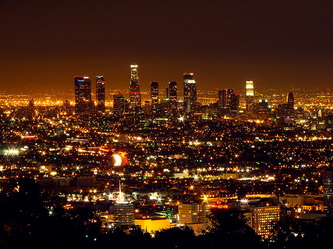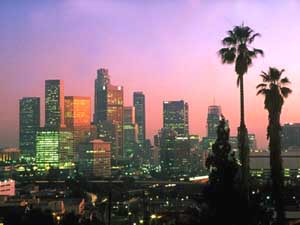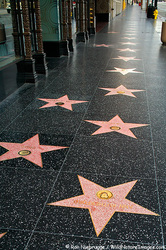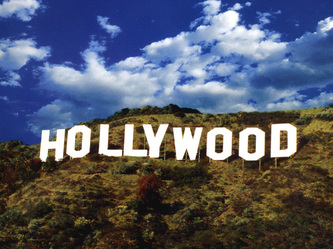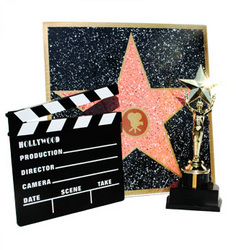History of Los Angeles
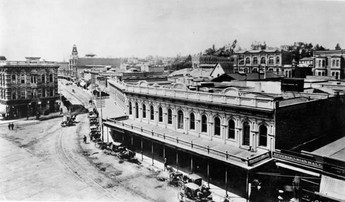
The city of Los Angeles is also known as the City of Angles. The county of Los Angeles was founded in 1781 and incorporated on February 18, 1850. Alpheus P. Hodges became Los Angeles’ first American elected mayor in 1850 (http://www.laalmanac.com, 2011). Los Angeles was one of the original 27 counties in CA. The treaty of Cahuenga, signed in 1847, ended the war in California, adding Los Angeles and the rest of California to American territory (http://www.city-data.com, 2010). After the gold rush of 1848 Los Angeles’ population growth sky rocketed. By 1890 the population was at one thousand and steadily growing. Also during this time oil was discovered in the city and soon the population exploded.
In the 1900s, agriculture became an key factor to the economy. By the 1930’s Los Angeles was nicknamed “Tinsletown” because of all the motion picture success. World War II brought hundreds of new industries to the area, boosting the local economy (http://www.city-data.com, 2010). By the 1950s, Los Angeles became a thriving metropolis. It was considered the epitome of everything new and modern in American culture (http://www.city-data.com, 2010). In the 1960s things took a turn for the worst when the Los Angeles dream began to fade. Despite the continued construction of new freeways, traffic congestion became a major problem; industry and auto emissions created smog and pollution. Frustration over living conditions came to a head in August 1965, when riots erupted in the African American ghetto of Watts, and more unrest developed in the Hispanic communities of East Los Angeles (http://www.city-data.com, 2010). The reactions to these new problems included the city adopting strict air pollution guidelines, along with taking steps to bring minorities into the political process. In 1937, the city’s first black mayor, Tom Bradley, was elected. Over the next two decades public transportation was improved, and a subway system was funded and began limited operations. The downtown area became a thriving district of impressive glass skyscrapers (http://www.city-data.com, 2010). Los Angeles began to get back on their feet and come out of the recession in the mid 1990s, but like much of the country the city took another hit with the terrorist attacks on September 11, 2001. IN response to this devastating event that impacted the people and the economy, the mayor at the time created the Los Angeles Economic Impact Task Force, which brought together business leaders from across the city to develop recommendations for strengthening the local economy (http://www.city-data.com, 2010). The result has been an increase in tourism, retail sales. Los Angeles began to recover.
In the 1900s, agriculture became an key factor to the economy. By the 1930’s Los Angeles was nicknamed “Tinsletown” because of all the motion picture success. World War II brought hundreds of new industries to the area, boosting the local economy (http://www.city-data.com, 2010). By the 1950s, Los Angeles became a thriving metropolis. It was considered the epitome of everything new and modern in American culture (http://www.city-data.com, 2010). In the 1960s things took a turn for the worst when the Los Angeles dream began to fade. Despite the continued construction of new freeways, traffic congestion became a major problem; industry and auto emissions created smog and pollution. Frustration over living conditions came to a head in August 1965, when riots erupted in the African American ghetto of Watts, and more unrest developed in the Hispanic communities of East Los Angeles (http://www.city-data.com, 2010). The reactions to these new problems included the city adopting strict air pollution guidelines, along with taking steps to bring minorities into the political process. In 1937, the city’s first black mayor, Tom Bradley, was elected. Over the next two decades public transportation was improved, and a subway system was funded and began limited operations. The downtown area became a thriving district of impressive glass skyscrapers (http://www.city-data.com, 2010). Los Angeles began to get back on their feet and come out of the recession in the mid 1990s, but like much of the country the city took another hit with the terrorist attacks on September 11, 2001. IN response to this devastating event that impacted the people and the economy, the mayor at the time created the Los Angeles Economic Impact Task Force, which brought together business leaders from across the city to develop recommendations for strengthening the local economy (http://www.city-data.com, 2010). The result has been an increase in tourism, retail sales. Los Angeles began to recover.
Los Angeles Today
With a population of 9,348,011, Los Angeles is the 3rd largest city in the United States. Around 74% of the population is white and 48% are Hispanic or Latino. 14,940,000 of Los Angeles inhabitants live in urban areas and 15,250,000 live in a metro areas. The major exports of this city include aircraft engines and parts, electronic circuits, computer parts and accessories, and diamonds. Some major imports are medium passenger vehicles, crude oil, color television equipment, and larger passenger vehicles. The total land area of Los Angeles is 4,060.87 sq. miles making the city 498.3 sq. miles, water 29.2 sq. miles, and elevation 340 feet above sea level. English is the most spoken language with Spanish as a close second.
Los Angeles posses a unique title of one of the most multicultural cities in the United States. in 1932 and 1984 they hosted the summer Olympics. Los Angeles became a “home base” of Hollywood which is refered to as the “Entertainment Capital of the World”. Hollywood is leading the world in creation of movies, music videos, television production, and recorded music. Los Angles is home to the University of Southern California and University of California Los Angeles. L.A is also home to one of the largest airports in the world. The Los Angeles International Airport or L.A.X for short, Ranked sixth in the world for number of passengers and 13th in tonnage of air cargo handled (http://www.lawa.org, 2011).
Los Angeles posses a unique title of one of the most multicultural cities in the United States. in 1932 and 1984 they hosted the summer Olympics. Los Angeles became a “home base” of Hollywood which is refered to as the “Entertainment Capital of the World”. Hollywood is leading the world in creation of movies, music videos, television production, and recorded music. Los Angles is home to the University of Southern California and University of California Los Angeles. L.A is also home to one of the largest airports in the world. The Los Angeles International Airport or L.A.X for short, Ranked sixth in the world for number of passengers and 13th in tonnage of air cargo handled (http://www.lawa.org, 2011).
Hollywood (http://www.u-s-history.com)
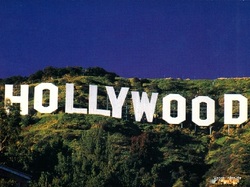
Established in 1853. It started as a thriving agricultural town. Harvey Henderson Wilcox bought 160 acres of land west of the city. The towns name came from Daeida who liked the name when a lady told him on a train about the town Hollywood in Ohio where she lived. He named his ranch back home Hollywood. On February 1, 1887, Wilcox submitted a grid map of his new town to the Los Angeles County records office. The first street was named Prospect Avenue, but later changed to Hollywood Boulevard, where city lots were carved out around dirt avenues and pepper trees.
By the 1900s, Hollywood had a population of 500. There was a post office, a newspaper, a hotel, and two markets. By 1902, the first portion of the famous Hollywood Hotel had been built. A new trolley car system had been created in 1904, cutting travel time dramatically. The system was called the "Hollywood Boulevard." Due to its ongoing struggles to maintain an adequate water supply, residents voted to have Hollywood annexed by the City of Los Angeles and its new aqueduct system.
In the early 1900s, filmmakers began moving to the Los Angeles area to get away from the strict rules imposed by Thomas Edison's Motion Picture Patents Company in New Jersey. To escape his control, movie makers began to arrive in Los Angeles to make their films. Working without disturbance from Edison, the Biograph Company moved west with actors Blanche Sweet, Lillian Gish, Mary Pickford, Lionel Barrymore, and others, to make their films. After beginning filming in Los Angeles, the company decided to explore the neighboring area and stumbled across Hollywood.
Biograph made the first film in Hollywood, entitled In Old California. After hearing of Biograph's praise of the area, other filmmakers headed west to set up shop. The first motion picture studio was built in 1919, in nearby Edendale, just east of Hollywood, and the first one built in Hollywood was founded by filmmaker David Horsley's general manager Al Christie in 1911, in an old building on the southeast corner of Sunset Boulevard and Gower Street. Movie studios began to pop up all over Hollywood after Christie's appearance, including ones for Cecil B. DeMille in 1913, the Charlie Chaplin Studio in 1917, and many others.
The origin of the famous "Hollywood" sign is embedded in Americana. It was installed originally to advertise a new subdivision near the top of Mount Lee, called "Hollywoodland."After being erected in 1923, the sign fell into disrepair. The Hollywood Chamber of Commerce was given authority to remove the last four letters and restore the remaining portions of the sign on the hillside, in 1943. The sign is now a registered trademark owned by the Chamber of Commerce, and may only be used in filming with their permission.
The famous "Hollywood Walk of Fame," where the names of celebrities are embedded in the sidewalk along Hollywood Boulevard, was built in 1956. There are some 2,200 five-pointed stars given by the Chamber for being significant contributors to the entertainment industry.
By the 1900s, Hollywood had a population of 500. There was a post office, a newspaper, a hotel, and two markets. By 1902, the first portion of the famous Hollywood Hotel had been built. A new trolley car system had been created in 1904, cutting travel time dramatically. The system was called the "Hollywood Boulevard." Due to its ongoing struggles to maintain an adequate water supply, residents voted to have Hollywood annexed by the City of Los Angeles and its new aqueduct system.
In the early 1900s, filmmakers began moving to the Los Angeles area to get away from the strict rules imposed by Thomas Edison's Motion Picture Patents Company in New Jersey. To escape his control, movie makers began to arrive in Los Angeles to make their films. Working without disturbance from Edison, the Biograph Company moved west with actors Blanche Sweet, Lillian Gish, Mary Pickford, Lionel Barrymore, and others, to make their films. After beginning filming in Los Angeles, the company decided to explore the neighboring area and stumbled across Hollywood.
Biograph made the first film in Hollywood, entitled In Old California. After hearing of Biograph's praise of the area, other filmmakers headed west to set up shop. The first motion picture studio was built in 1919, in nearby Edendale, just east of Hollywood, and the first one built in Hollywood was founded by filmmaker David Horsley's general manager Al Christie in 1911, in an old building on the southeast corner of Sunset Boulevard and Gower Street. Movie studios began to pop up all over Hollywood after Christie's appearance, including ones for Cecil B. DeMille in 1913, the Charlie Chaplin Studio in 1917, and many others.
The origin of the famous "Hollywood" sign is embedded in Americana. It was installed originally to advertise a new subdivision near the top of Mount Lee, called "Hollywoodland."After being erected in 1923, the sign fell into disrepair. The Hollywood Chamber of Commerce was given authority to remove the last four letters and restore the remaining portions of the sign on the hillside, in 1943. The sign is now a registered trademark owned by the Chamber of Commerce, and may only be used in filming with their permission.
The famous "Hollywood Walk of Fame," where the names of celebrities are embedded in the sidewalk along Hollywood Boulevard, was built in 1956. There are some 2,200 five-pointed stars given by the Chamber for being significant contributors to the entertainment industry.
Attractions
- Grauman’s Chinese Theater- one of the most famous movie theaters in the world. Millions of visitors from around the world are drawn to the forecourt with footprints and hand prints of the stars imprinted into concrete outside the theater.
- Hollywood Sign- famous landmark in the Hollywood hills; created as a advertisement originally for the neighborhood close by. They later took down part of the sign so it would just say Hollywood. It now is one of the most famous landmarks in the world.
- Universal Studio- Family attraction complete with a water park, amusement park and 3D shows.
- Hollywood Walk of Fame- While walking down the Boulevard you look down and see these renowned sidewalk "stars" that salute the celebrities who made Hollywood.
- Kodak Theater- Host of the Academy Awards, the Kodak theater is a must visit.
- Capital Records- Leading recording label in the U.S, with an iconic building in L.A that you can tour.
- Hollywood Bowl- Hosted in the Walt Disney Concert Hall, the Hollywood bowl puts on a numerous amounts of concerts.
